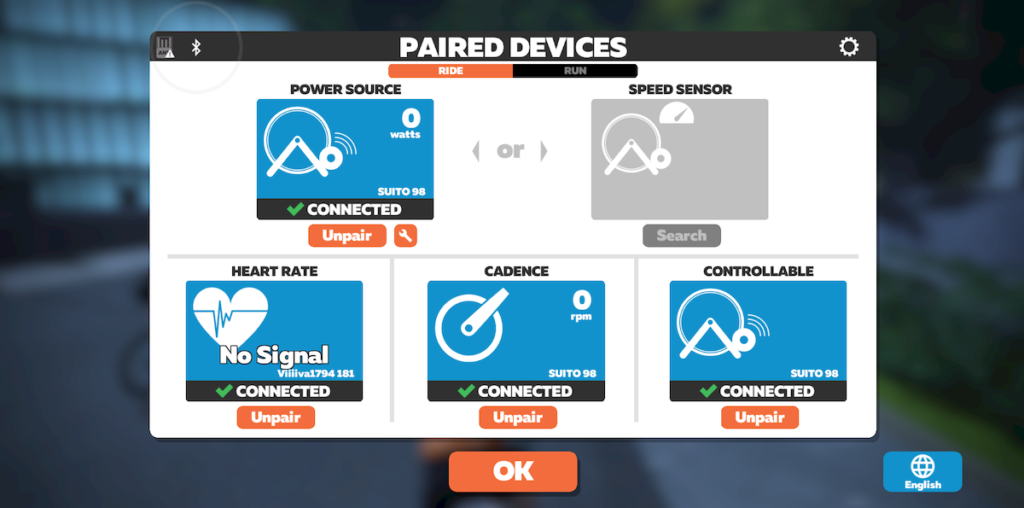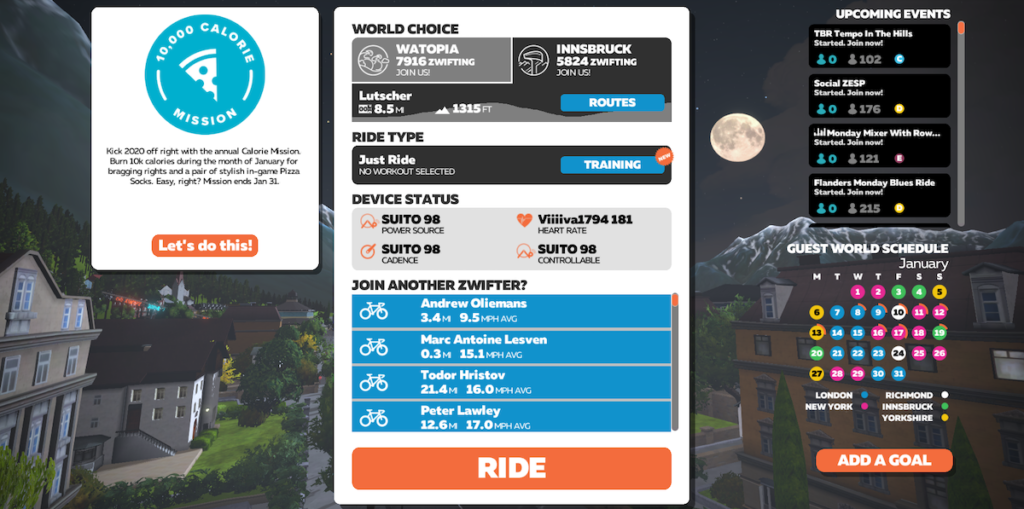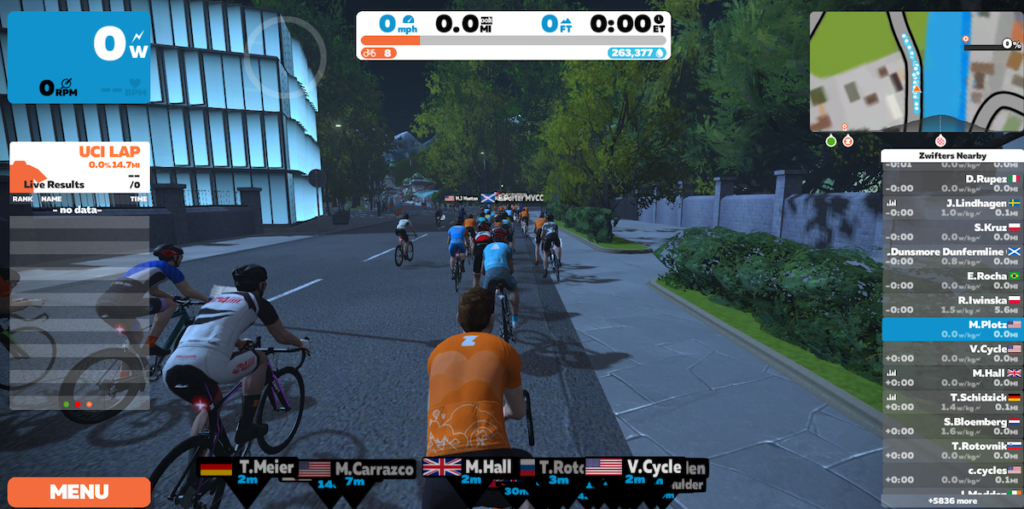
Master and servant (not pictured). Pardon the clutter, I Zwift at the shop.
I don’t have fitness goals, I have lifestyle goals. I want to drink IPAs when desired, not count calories, and keep the same clothing size… because, while wardrobe churn is long overdue, I need to reserve my money for things lower down in Maslow’s hierarchy.
The User
Pursuant to my lifestyle goals I find myself on the road to nowhere with increasing frequency. I have an aging set of CycleOps rollers which I’ll spend 30 minutes on a few times per week. The rollers have magnetic resistance so I can get a workout without having to spin out a 53 x 11. I have a few self-imposed workouts I use:
Resistance 5/5
- Start in 53 x 28 and pedal for 5 minutes. Then drop down to the next smaller cog (25t) and pedal for 5 more minutes. Then another cog and another 5. The goal is to get to 30 minutes without vomiting or putting a foot down, and keeping cadance in the 100-120 range. Trust me, this is hard.
- Start in 53 x 28 and pedal for 5 minutes. Then drop down 3 cogs (19t) and pedal for 2 minutes. Then bump up one cog (21t) for 3 minutes. Then bump up one more to start the next 10 minute block.
Resistance 4/5
- Follow the regimen of the first bullet point but start one cog down the stack (25t).
If I keep my heart rate at/above 150 bpm and my cadence ~110 rpm, then I get a good sweat and I feel the Bern riding home from the shop. But if the world is to keep turning and humanity is to keep improving then one’s reach should always exceed one’s grasp. And what I was reaching for (and failing to grasp) was another Lupulin IPA and/or slice of Pizza Luce (Fire breathing dragon, vegan style). I had to figure out how to burn more calories.
Rollers are a fun skill to master but they have downsides: noise, tire wear, and the need for constant focus by the rider. Thirty minutes is my limit when I’m staring at my front tire and metrics on my bike computer. Over the years I have heard tales of people spending 1, 2, even 3 hours on the stationary trainer. How were they doing it?
I decided to check out Zwift. A number of people I follow on Strava were using it, and so were some of our customers. Zwift has a 7 day free trial. There seemed to be no downside.

Pairing your bluetooth devices is simple and the software is reliable.
Zwifting
I went to their website and downloaded the app to my iMac. I answered a few questions about my height and weight and then I was teleported to Watopia. Wapotia is a fantasy land populated by dinosaurs and people who sustain outputs of >5 watts/kg. The dinosaurs are more real than those TdF riders — none of whom I’ve caught and whose existence is only revealed by fleeting appearances on the slate of ‘Riders near me.’
Watopia seems to be a mash-up of Atlantis, Big Sur, the Italian Alps, and the Brady Bunch Tiki god episode. I set the graphics to 1080p which was all my 2013 iMac and Comcast connection could handle. At those settings you can expect a world reminiscent of Ridge Racer circa PS3 days.
But whatever, because riding in real life, I’m not trying to look at the scenery; I’m there to chase down the person in front of me while making sure the numbers of my bike computer are what they ought to be. On both counts Zwift is a great training partner — nay, enabler.
Time for a ride. I loaded the app and rotated my 27” monitor to face the rollers. The program helpfully locates and syncs with any bluetooth transmitters you use. I synced my heart rate monitor, cadence sensor, and speed sensor. For the program to recognize ANT+ devices it requires a ANT+ usb dongle for your computer.
The program also asks what trainer you use. Here’s where I encountered some difficulty. Zwift is compatible with dumb trainers (aka a trainer you don’t have plug in) but its database is limited. My rollers weren’t in the database so I selected ‘Generic Rollers’ for one ride and ‘Cyclops Mag trainer’ for the next ride. The first vastly underestimated my power while the other upped my FTP to the mid 300 watts after a 40 minute ride. Allow me to decode that: I’m not a Cat 1 racer in my mid 20s as Zwift was suggesting.
Compatibility and useability are different things. On a flat road Zwift takes a reading from your speed and cadence sensors and determines your power output. It works fine; go faster or slower by choosing a harder or easier gear, and you will do more or less work while pedaling. But when the road turns up the experience gets a little cartoonish: your speed starts to drop and the world around you slows down. WTF? Oh, you’re on a climb so to increase your speed you will need to increase your cadence or drop into a harder gear. In the game you will be moving at 5 mph but your wheel on the trainer may be moving at 25-30 mph. Hello dissonance!
But it all mostly works. Unless you are on rollers. Thanks to Zwift I ended a decade-long streak of riding the rollers without a fall. The next streak lasted 3 minutes. Then 2 minutes. Then 4 minutes. A pattern seemed to be emerging: when I got into the game (‘Close the gap!’) I paid less attention to my front wheel and, oops, there goes my balance. I needed a more stable platform if this was going to continue.
Direct Drive
There are three types of trainers: rollers, rear wheel trainers (your wheel contacts a roller; the roller provides the resistance); and direct drive trainers (remove the rear wheel and throw your chain on the trainer’s cassette). Sparing the tire is the big advantage of the direct drive trainer. A subset of these trainers is smart or dumb. Smart trainers plug in and can relay speed, cadence and power data. The newest generation of smart trainers can interface with Zwift and vary resistance according to terrain. The road pitches up and suddenly your effort increases. Goodbye dissonance!
I did some research on direct drive trainers. I checked my personal bank account. I considered power meters. The Elite Suito ($799) looked like the best value (1 month of Zwift and a Shimano R7000 11-28 cassette) and got positive reviews. I lept. A day later it was here.
Unboxing the Elite Suito
Direct drive trainers can be stupid heavy due to large flywheels. They can be loud. This trainer is neither. Pick it up by the handle (nice feature), place it on the floor, fold out the legs, and adjust the feet so the unit is level. Attach the bike by snapping the correct axle ends onto the trainer, lay the chain across a cog, nestle the frame’s dropouts onto the trainer, and close the quick release. Plug it in. Start Zwift. In less than 3 minutes you are ready to go. No pairing problems. Nothing. Easy. Integrated. Seamless.
Things to keep in mind: 1) your derailleur may need an adjustment to optimize shifting (mine did — my hanger was a little bent); 2) you need to level the bike (I used a bubble level on the seat tube and adjusted the trainer’s feet; and 3) rear disc brake calipers need either a pad separator inserted or (better) the pads pulled and a bleed block inserted. I recommend this third precaution because it is too easy to squeeze the rear brake lever; without a rotor between the pads (remember removing the rear wheel?) you will dislodge the pistons. Oops! Now you’ve got hydraulic fluid all over your new trainer.

Once your sensors are paired it is time to select a course or workout. You can join others if you don’t want to ride solo.
Smart Zwifting
I love it. It is so much better than intervals on rollers. It is so much better than Zwifting on a dumb trainer. I joined on January 8 and have logged almost 8 hours, >150 miles, and 12k feet of climbing. That is probably double or triple what I would have ridden without Zwift and the Elite trainer. Here’s why:
- Gamification. Early in this review I transitioned from calling Zwift an app to calling it a game. Zwift is constantly prodding you to go faster, to close the gap, to beat your old time, to up your watts per kg, etc. More evidence this is a game: it has a scoreboard. As you ride you accrue points. Said points can be used in the Zwift store to purchase virtual kit and custom bikes. I haven’t seen any prompting for in-app purchases — and I hope that’s not an option. Bottom line is that I’m extremely susceptible to this gamification so it does result in longer and faster rides.
- Socializing. Every time that I’ve logged on there have been >2k people Zwifting. That’s pretty rad. While you ride you can see what countries people are representing. And while it is predominantly North America there is also plenty of representation by Asia and Europe. You can give and get thumbs-up from other riders. I usually log on between 5 and 6 pm so I have started recognizing names. That’s motivating too.
- Depth. Every day there are two worlds and multiple rides in each world from which to choose. Newbies can’t access all the rides, you have to unlock them by putting in your time. Watopia is a constant (described above) and the other world rotates with NYC, Richmond VA, London, Innsbruck and Yorkshire. My favorite so far is Innsbruck, Austria, which uses the 2018 World Championship Course. That day I wanted a 30-40 minute workout. An 8 mile course with 1400 feet of climbing? Hello! Yes, please!!
- Variety. So far I have only ridden solo, but Zwift can connect you with other riders and you can even join races. I don’t like riding with other people IRL, so I think I will reprise my role as Plotz Solo.
- Fitness. I am in this predicament because I had lifestyle goals to pursue. Buying into the virtual riding world wasn’t cheap, but that cost is now behind me, and it is up to me to make sure that money was well spent. My reality is that I am a time constrained cyclist, approaching middle age, working two jobs: my health and my financial security are intertwined, so it behooves me to invest in my health.

That’s me in orange. The upper portion of the screen tells you wattage, hr, speed, elevation and milage. The left side shows information about the segment you are in. The right side shows you the riders near you, their speed, their effort, and their mileage that day.
Verdict
You can pay more for a smart trainer and you can pay less for a dumb trainer. The Elite Suito ($799) hits the sweet spot relative to its competition. If you pop for one (buy it from us!) then I highly recommend taking advantage of the one month of free Zwift. Drop by or give us a call if you have questions about the equipment or set up. We are always happy to chat. Catch you in Watopia! XOXOXO.
Bike: 2015 Cannondale Caad10 disc with Ultegra R8000 (Not for sale)
Trainer: Elite Suito ($799)
Accessories: 4iii heart rate monitor ($79)
iPhone mount: GoKase iPhone mount ($40)
Software: Zwift ($14.99/month)
Hardware: 2013 21″ iMac with 27″ external monitor